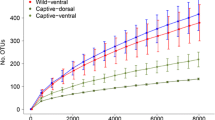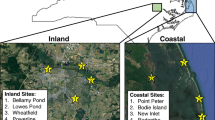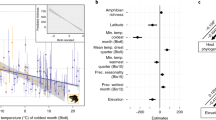Abstract
While a number of amphibian skin microbiomes have been characterized, it is unclear how these communities might vary in response to seasonal changes in the environment and the corresponding behaviors that many amphibians exhibit. Given recent studies demonstrating the importance of the skin microbiome in frog innate immune defense against pathogens, investigating how changes in the environment impact the microbial species present will provide a better understanding of conditions that may alter host susceptibility to pathogens in their environment. We sampled the bacterial skin microbiome of North American wood frogs (Rana sylvatica) from two breeding ponds in the spring, along with the bacterial community present in their vernal breeding pools, and frogs from the nearby forest floor in the summer and fall to determine whether community composition differs by sex, vernal pond site, or temporally across season (spring, summer, fall). Taxon relative abundance data reveals a profile of bacterial phyla similar to those previously described on anuran skin, with Proteobacteria, Bacteroidetes, and Actinobacteria dominating the wood frog skin microbiome. Our results indicate that sex had no significant effect on skin microbiota diversity; however, this may be due to our limited female frog sample size. Vernal pool site had a small but significant effect on skin microbiota, but skin-associated communities were more similar to each other than to the communities observed in the frogs’ respective pond water. Across seasons, diversity analyses suggest that there are significant differences between the bacterial skin microbiome of frogs from spring and summer/fall groups while the average α-diversity per frog remained consistent. These results illustrate seasonal variation in wood frog skin microbiome structure and highlight the importance of considering temporal trends in an amphibian microbiome, particularly for species whose life history requires recurrent shifts in habitat and behavior.







Similar content being viewed by others
Data Availability
16S rRNA gene amplicon sequence data for skin microbiome samples are deposited in the NCBI Sequence Read Archive (Bioproject PRJNA603391).
References
McKenzie VJ, Bowers RM, Fierer N et al (2012) Co-habiting amphibian species harbor unique skin bacterial communities in wild populations. ISME J 6:588–596. https://doi.org/10.1038/ismej.2011.129
Colombo BM, Scalvenzi T, Benlamara S, Pollet N (2015) Microbiota and mucosal immunity in amphibians. Front Immunol 6:1–15. https://doi.org/10.3389/fimmu.2015.00111
Walke JB, Becker MH, Hughey MC, Swartwout MC, Jensen RV, Belden LK (2015) Most of the dominant members of amphibian skin bacterial communities can be readily cultured. Appl Environ Microbiol 81:6589–6600. https://doi.org/10.1128/AEM.01486-15
Longo AV, Savage AE, Hewson I, Zamudio KR (2015) Seasonal and ontogenetic variation of skin microbial communities and relationships to natural disease dynamics in declining amphibians. R Soc Open Sci 2:140377. https://doi.org/10.1098/rsos.140377
Belden LK, Hughey MC, Rebollar EA, Umile TP, Loftus SC, Burzynski EA, Minbiole KPC, House LL, Jensen RV, Becker MH, Walke JB, Medina D, Ibáñez R, Harris RN (2015) Panamanian frog species host unique skin bacterial communities. Front Microbiol 6:1171. https://doi.org/10.3389/fmicb.2015.01171
Ellison S, Rovito S, Parra-Olea G, Vásquez-Almazán C, Flechas SV, Bi K, Vredenburg VT (2018) The influence of habitat and phylogeny on the skin microbiome of amphibians in Guatemala and Mexico. Microb Ecol 1–11:257–267. https://doi.org/10.1007/s00248-018-1288-8
Costa S, Lopes I, Proença DN, Ribeiro R, Morais PV (2016) Diversity of cutaneous microbiome of Pelophylax perezi populations inhabiting different environments. Sci Total Environ 572:995–1004. https://doi.org/10.1016/j.scitotenv.2016.07.230
Varga JFA, Bui-Marinos MP, Katzenback BA (2019) Frog skin innate immune defences: sensing and surviving pathogens. Front Immunol 10:3128. https://doi.org/10.3389/fimmu.2018.03128
Woodhams DC, Vredenburg VT, Simon MA, Billheimer D, Shakhtour B, Shyr Y, Briggs CJ, Rollins-Smith LA, Harris RN (2007) Symbiotic bacteria contribute to innate immune defenses of the threatened mountain yellow-legged frog, Rana muscosa. Biol Conserv 138:390–398. https://doi.org/10.1016/j.biocon.2007.05.004
Harris RN, Brucker RM, Walke JB, Becker MH, Schwantes CR, Flaherty DC, Lam BA, Woodhams DC, Briggs CJ, Vredenburg VT, Minbiole KPC (2009) Skin microbes on frogs prevent morbidity and mortality caused by a lethal skin fungus. ISME J 3:818–824. https://doi.org/10.1038/ismej.2009.27
Brucker RM, Baylor CM, Walters RL, Lauer A, Harris RN, Minbiole KPC (2008) The identification of 2,4-diacetylphloroglucinol as an antifungal metabolite produced by cutaneous bacteria of the salamander Plethodon cinereus. J Chem Ecol 34:39–43. https://doi.org/10.1007/s10886-007-9352-8
Lauer A, Simon MA, Banning JL, André E, Duncan K, Harris RN (2007) Common cutaneous bacteria from the eastern red-backed salamander can inhibit pathogenic fungi. Copeia 2007:630–640. https://doi.org/10.1643/0045-8511(2007)2007[630:CCBFTE]2.0.CO;2
Lauer A, Simon MA, Banning JL, Lam BA, Harris RN (2008) Diversity of cutaneous bacteria with antifungal activity isolated from female four-toed salamanders. ISME J 2:145–157. https://doi.org/10.1038/ismej.2007.110
Daszak P, Cunningham AA, Hyatt AD (2003) Infectious disease and amphibian population declines. Divers Distrib 9:141–150. https://doi.org/10.1046/j.1472-4642.2003.00016.x
Kilpatrick AM, Briggs CJ, Daszak P (2010) The ecology and impact of chytridiomycosis: an emerging disease of amphibians. Trends Ecol Evol 25:109–118. https://doi.org/10.1016/j.tree.2009.07.011
Harris RN, Lauer A, Simon MA, Banning JL, Alford RA (2009) Addition of antifungal skin bacteria to salamanders ameliorates the effects of chytridiomycosis. Dis Aquat Org 83:11–16. https://doi.org/10.3354/dao02004
Kueneman JG, Woodhams DC, Harris R, Archer HM, Knight R, McKenzie VJ (2016) Probiotic treatment restores protection against lethal fungal infection lost during amphibian captivity. Proc R Soc B Biol Sci 283:20161553. https://doi.org/10.1098/rspb.2016.1553
Berven KA, Gill DE (1983) Interpreting geographic variation in life-history traits. Integr Comp Biol 23:85–97. https://doi.org/10.1093/icb/23.1.85
Berven KA (1990) Factors affecting population fluctuations in larval and adult stages of the wood frog (Rana sylvatica). Ecology 71:1599–1608. https://doi.org/10.2307/1938295
Matutte B, Storey KB, Knoop FC, Conlon JM (2000) Induction of synthesis of an antimicrobial peptide in the skin of the freeze-tolerant frog, Rana sylvatica, in response to environmental stimuli. FEBS Lett 483:135–138. https://doi.org/10.1016/S0014-5793(00)02102-5
Storey KB, Storey JSKM (1992) Natural freeze tolerance in ectothermic vertebrates. Annu Rev Physiol 54:619–637. https://doi.org/10.1146/annurev.physiol.54.1.619
Gahl MK, Longcore JE, Houlahan JE (2012) Varying responses of northeastern north American amphibians to the chytrid pathogen Batrachochytrium dendrobatidis. Conserv Biol 26:135–141. https://doi.org/10.1111/j.1523-1739.2011.01801.x
Forzán MJ, Jones KM, Ariel E, Whittington RJ, Wood J, Markham RJF, Daoust PY (2017) Pathogenesis of frog virus 3 (Ranavirus, Iridoviridae) infection in wood frogs (Rana sylvatica). Vet Pathol 54:531–548. https://doi.org/10.1177/0300985816684929
Walke JB, Becker MH, Loftus SC, House LL, Teotonio TL, Minbiole KPC, Belden LK (2015) Community structure and function of amphibian skin microbes: an experiment with bullfrogs exposed to a chytrid fungus. PLoS One 10:e0139848. https://doi.org/10.1371/journal.pone.0139848
Becker MH, Walke JB, Cikanek S, Savage AE, Mattheus N, Santiago CN, Minbiole KPC, Harris RN, Belden LK, Gratwicke B (2015) Composition of symbiotic bacteria predicts survival in Panamanian golden frogs infected with a lethal fungus. Proc R Soc B Biol Sci 282:20142881–20142881. https://doi.org/10.1098/rspb.2014.2881
Rebollar EA, Gutiérrez-Preciado A, Noecker C, Eng A, Hughey MC, Medina D, Walke JB, Borenstein E, Jensen RV, Belden LK, Harris RN (2018) The skin microbiome of the neotropical frog Craugastor fitzingeri: inferring potential bacterial-host-pathogen interactions from metagenomic data. Front Microbiol 9:466. https://doi.org/10.3389/fmicb.2018.00466
Walters W, Hyde ER, Berg-Lyons D et al (2016) Improved bacterial 16S rRNA gene (V4 and V4-5) and fungal internal transcribed spacer marker gene primers for microbial community surveys. mSystems 1:e00009-15. https://doi.org/10.1128/mSystems.00009-15
Apprill A, Mcnally S, Parsons R, Weber L (2015) Minor revision to V4 region SSU rRNA 806R gene primer greatly increases detection of SAR11 bacterioplankton. Aquat Microb Ecol 75:129–137. https://doi.org/10.3354/ame01753
Parada AE, Needham DM, Fuhrman JA (2016) Every base matters: assessing small subunit rRNA primers for marine microbiomes with mock communities, time series and global field samples. Environ Microbiol 18:1403–1414. https://doi.org/10.1111/1462-2920.13023
Bolyen E, Rideout JR, Dillon MR, Bokulich NA, Abnet CC, al-Ghalith GA, Alexander H, Alm EJ, Arumugam M, Asnicar F, Bai Y, Bisanz JE, Bittinger K, Brejnrod A, Brislawn CJ, Brown CT, Callahan BJ, Caraballo-Rodríguez AM, Chase J, Cope EK, da Silva R, Diener C, Dorrestein PC, Douglas GM, Durall DM, Duvallet C, Edwardson CF, Ernst M, Estaki M, Fouquier J, Gauglitz JM, Gibbons SM, Gibson DL, Gonzalez A, Gorlick K, Guo J, Hillmann B, Holmes S, Holste H, Huttenhower C, Huttley GA, Janssen S, Jarmusch AK, Jiang L, Kaehler BD, Kang KB, Keefe CR, Keim P, Kelley ST, Knights D, Koester I, Kosciolek T, Kreps J, Langille MGI, Lee J, Ley R, Liu YX, Loftfield E, Lozupone C, Maher M, Marotz C, Martin BD, McDonald D, McIver LJ, Melnik AV, Metcalf JL, Morgan SC, Morton JT, Naimey AT, Navas-Molina JA, Nothias LF, Orchanian SB, Pearson T, Peoples SL, Petras D, Preuss ML, Pruesse E, Rasmussen LB, Rivers A, Robeson II MS, Rosenthal P, Segata N, Shaffer M, Shiffer A, Sinha R, Song SJ, Spear JR, Swafford AD, Thompson LR, Torres PJ, Trinh P, Tripathi A, Turnbaugh PJ, Ul-Hasan S, van der Hooft JJJ, Vargas F, Vázquez-Baeza Y, Vogtmann E, von Hippel M, Walters W, Wan Y, Wang M, Warren J, Weber KC, Williamson CHD, Willis AD, Xu ZZ, Zaneveld JR, Zhang Y, Zhu Q, Knight R, Caporaso JG (2019) Reproducible, interactive, scalable and extensible microbiome data science using QIIME 2. Nat Biotechnol 37:852–857. https://doi.org/10.1038/s41587-019-0209-9
Callahan BJ, McMurdie PJ, Rosen MJ et al (2016) DADA2: high-resolution sample inference from Illumina amplicon data. Nat Methods 13:581–583. https://doi.org/10.1038/nmeth.3869
Yilmaz P, Parfrey LW, Yarza P, Gerken J, Pruesse E, Quast C, Schweer T, Peplies J, Ludwig W, Glöckner FO (2014) The SILVA and “all-species Living Tree Project (LTP)” taxonomic frameworks. Nucleic Acids Res 42:D643–D648. https://doi.org/10.1093/nar/gkt1209
Katoh K, Misawa K, Kuma K, Miyata T (2002) MAFFT: a novel method for rapid multiple sequence alignment based on fast Fourier transform. Nucleic Acids Res 30:3059–3066. https://doi.org/10.1093/nar/gkf436
Stamatakis A (2014) RAxML version 8: a tool for phylogenetic analysis and post-analysis of large phylogenies. Bioinformatics 30:1312–1313. https://doi.org/10.1093/bioinformatics/btu033
Medina D, Hughey MC, Becker MH, Walke JB, Umile TP, Burzynski EA, Iannetta A, Minbiole KPC, Belden LK (2017) Variation in metabolite profiles of amphibian skin bacterial communities across elevations in the Neotropics. Microb Ecol 74:227–238. https://doi.org/10.1007/s00248-017-0933-y
Shade A, Handelsman J (2012) Beyond the Venn diagram: the hunt for a core microbiome. Environ Microbiol 14:4–12. https://doi.org/10.1111/j.1462-2920.2011.02585.x
Muletz-Wolz CR, Almario JG, Barnett SE, DiRenzo GV, Martel A, Pasmans F, Zamudio KR, Toledo LF, Lips KR (2017) Inhibition of fungal pathogens across genotypes and temperatures by amphibian skin bacteria. Front Microbiol 8:1551. https://doi.org/10.3389/fmicb.2017.01551
Ellison S, Knapp RA, Sparagon W, Swei A, Vredenburg VT (2019) Reduced skin bacterial diversity correlates with increased pathogen infection intensity in an endangered amphibian host. Mol Ecol 28:127–140. https://doi.org/10.1111/mec.14964
Walke JB, Becker MH, Loftus SC, House LL, Cormier G, Jensen RV, Belden LK (2014) Amphibian skin may select for rare environmental microbes. ISME J 8:2207–2217. https://doi.org/10.1038/ismej.2014.77
Berven KA, Grudzien TA (1990) Dispersal in the wood frog (Rana sylvatica): implications for genetic population structure. Evolution (N Y) 44:2047–2056. https://doi.org/10.2307/2409614
Prado-Irwin SR, Bird AK, Zink AG, Vredenburg VT (2017) Intraspecific variation in the skin-associated microbiome of a terrestrial salamander. Microb Ecol 74:745–756. https://doi.org/10.1007/s00248-017-0986-y
Muletz-Wolz CR, Yarwood SA, Campbell Grant EH et al (2018) Effects of host species and environment on the skin microbiome of Plethodontid salamanders. J Anim Ecol 87:341–353. https://doi.org/10.1111/1365-2656.12726
Bletz MC, Archer H, Harris RN, McKenzie VJ, Rabemananjara FCE, Rakotoarison A, Vences M (2017) Host ecology rather than host phylogeny drives amphibian skin microbial community structure in the biodiversity hotspot of Madagascar. Front Microbiol 8:1530. https://doi.org/10.3389/fmicb.2017.01530
Albecker MA, Belden LK, McCoy MW (2018) Comparative analysis of anuran amphibian skin microbiomes across inland and coastal wetlands. Microb Ecol 78:348–360. https://doi.org/10.1007/s00248-018-1295-9
Krynak KL, Burke DJ, Benard MF (2016) Landscape and water characteristics correlate with immune defense traits across Blanchard’s cricket frog (Acris blanchardi) populations. Biol Conserv 193:153–167. https://doi.org/10.1016/j.biocon.2015.11.01948
Fierer N, Hamady M, Lauber CL, Knight R (2008) The influence of sex, handedness, and washing on the diversity of hand surface bacteria. Proc Natl Acad Sci 105:17994–17999. https://doi.org/10.1073/pnas.0807920105
Saag P, Tilgar V, Mänd R, Kilgas P, Mägi M (2011) Plumage bacterial assemblages in a breeding wild passerine: relationships with ecological factors and body condition. Microb Ecol 61:740–749. https://doi.org/10.1007/s00248-010-9789-0
Campbell LJ, Garner TWJ, Hopkins K, Griffiths AGF, Harrison XA (2019) Outbreaks of an emerging viral disease covary with differences in the composition of the skin microbiome of a wild United Kingdom amphibian. Front Microbiol 10:1245. https://doi.org/10.3389/fmicb.2019.01245
Chase AB, Karaoz U, Brodie EL, Gomez-Lunar Z, Martiny AC, Martiny JBH (2017) Microdiversity of an abundant terrestrial bacterium encompasses extensive variation in ecologically relevant traits. MBio 8. https://doi.org/10.1128/mBio.01809-17
Kielak AM, Barreto CC, Kowalchuk GA, van Veen JA, Kuramae EE (2016) The ecology of Acidobacteria: moving beyond genes and genomes. Front Microbiol 7:744. https://doi.org/10.3389/fmicb.2016.00744
Grönroos M, Parajuli A, Laitinen OH, Roslund MI, Vari HK, Hyöty H, Puhakka R, Sinkkonen A (2019) Short-term direct contact with soil and plant materials leads to an immediate increase in diversity of skin microbiota. MicrobiologyOpen 8:e00645. https://doi.org/10.1002/mbo3.645
Zaheer R, Noyes N, Ortega Polo R, Cook SR, Marinier E, van Domselaar G, Belk KE, Morley PS, McAllister TA (2018) Impact of sequencing depth on the characterization of the microbiome and resistome. Sci Rep 8:5890. https://doi.org/10.1038/s41598-018-24280-8
McMurdie PJ, Holmes S (2014) Waste not, want not: why rarefying microbiome data is inadmissible. PLoS Comput Biol 10:e1003531. https://doi.org/10.1371/journal.pcbi.1003531
Longo AV, Zamudio KR (2017) Temperature variation, bacterial diversity and fungal infection dynamics in the amphibian skin. Mol Ecol 26:4787–4797. https://doi.org/10.1111/mec.14220
Muletz-Wolz CR, Fleischer RC, Lips KR (2019) Fungal disease and temperature alter skin microbiome structure in an experimental salamander system. Mol Ecol 28:mec.15122. https://doi.org/10.1111/mec.15122
Zhou J, Deng Y, Shen L, Wen C, Yan Q, Ning D, Qin Y, Xue K, Wu L, He Z, Voordeckers JW, Nostrand JDV, Buzzard V, Michaletz ST, Enquist BJ, Weiser MD, Kaspari M, Waide R, Yang Y, Brown JH (2016) Temperature mediates continental-scale diversity of microbes in forest soils. Nat Commun 7:12083. https://doi.org/10.1038/ncomms12083
Maniero GD, Carey C (1997) Changes in selected aspects of immune function in the leopard frog, Rana pipiens, associated with exposure to cold. J Comp Physiol B 167:256–263. https://doi.org/10.1109/LARS
Katzenback BA, Holden HA, Falardeau J, Childers C, Hadj-Moussa H, Avis TJ, Storey KB (2014) Regulation of the Rana sylvatica brevinin-1SY antimicrobial peptide during development and in dorsal and ventral skin in response to freezing, anoxia and dehydration. J Exp Biol 217:1392–1401. https://doi.org/10.1242/jeb.092288
Acknowledgments
The authors thank Nicole Wang for the generous contribution of a trained taxonomic classifier for 16S rRNA gene sequences and Maxwell P. Bui-Marinos, Joseph F.A. Varga, and Nathanael B. J. Harper for their technical assistance in collecting frog skin swabs.
Funding
This study was funded by a Natural Sciences and Engineering Research Council of Canada Discovery Grant (NSERC DG) to BAK (Grant # RGPIN-2017-04218), a Tier II Canada Research Chair to LAH, and salary support to AJD through a Natural Sciences and Engineering Research Council of Canada Undergraduate Summer Research Assistantship (NSERC USRA), the University of Waterloo Undergraduate Research Internship (URI) funding initiative, as well as a Graduate Research Studentship, Science Graduate Award, and UW Graduate Scholarship awarded by the University of Waterloo, Department of Biology.
Author information
Authors and Affiliations
Contributions
AJD, LAH, and BAK conceived the study; AJD and BAK performed field sampling; AJD performed the experiments and analyzed the data; AJD, LAH, and BAK wrote and critically revised the manuscript.
Corresponding author
Ethics declarations
Conflict of Interest
The authors declare that they have no conflict of interest.
Ethical Approval
All applicable international, national, and/or institutional guidelines for the care and use of animals were followed. All procedures performed in studies involving animals were in accordance with the ethical standards of the institution at which the studies were conducted (University of Waterloo Animal Care Committee and the Canadian Council on Animal Care, Animal Utilization Projects #30008 and #40721), and animals were captured under the Ontario Ministry of Natural Resources and Forestry Wildlife Scientific Collectors Authorization Permits (#1088586 and #1092603 issued to Dr. B.A. Katzenback). This article does not contain any studies with human participants performed by any of the authors.
Rights and permissions
About this article
Cite this article
Douglas, A.J., Hug, L.A. & Katzenback, B.A. Composition of the North American Wood Frog (Rana sylvatica) Bacterial Skin Microbiome and Seasonal Variation in Community Structure. Microb Ecol 81, 78–92 (2021). https://doi.org/10.1007/s00248-020-01550-5
Received:
Accepted:
Published:
Issue Date:
DOI: https://doi.org/10.1007/s00248-020-01550-5




